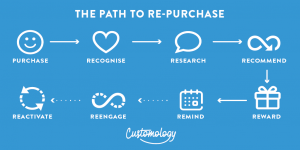15 Aug Why you should align the marketing planning process to the customer lifecycle

Each year, professional marketers undertake a marketing planning process, which involves a great deal of strategy in determining the best way to meet the brand’s overall business objectives. It’s quite common for marketing objectives to be aligned to acquisition growth, such as; win x% of new customers, grow subscription base by x%, increase social followers by x%.
Sometimes the engagement objectives are seen as a lower priority, when in fact, they should be at the top of the list. Everyone is talking about the importance of customer retention, yet when it comes to marketing strategy the focus remains predominantly on acquisition.
No one size fits all
There are many brands who do not segment their customer base, not effectively anyway. When sending marketing communications, it’s often a blast to the entire customer base, with the exact same message. Not all customers are equal, and your marketing needs to reflect that. If I live in Brisbane, then i’m not interested in flights on sale from Perth, if I bought a new coffee table, it doesn’t mean i’m also shopping for a new wardrobe. Too many communications are being shared which are completely irrelevant to the customer, not to mention the vast volume being sent. The majority of them with an offer, sale or promotion. Customers want messages relevant to them – there is no one size fits all when it comes to marketing communications.
What role can the customer lifecycle play?
With some basic data, you have enough to understand their position in the lifecycle. Basics to look at include; how much they have spent with you, when they last shopped with you and how often they shop with you, and what they have purchased. You will then be able to segment your customers based on their actual behaviour (not an assumed persona). Are they advocates? did they used to be, but haven’t been back in a while? Did they shop once with you and never return? You see where we are going with this, what’s clear is that each of these customers require a different form of marketing message. You really need to consider this when planning your marketing strategy.
The path to re-purchase

The above graphic represents Customology’s path to re-purchase. It’s designed to help brands continue a conversation with the customer to keep them engaged, and inevitably drive them back in store or online. Once you have segmented your customer base, you can determine which stage they are at, some may need rewarding for being such loyal customers, others may need completely re-activating and offered a small (relevant) incentive to return.
Once you are aware of how many customers you have lost, and who are not engaged, you will realise how much of your budget you have wasted in marketing to these customers.
Dedicate a separate budget to keep your existing customers happy
Speaking of budgets, when it comes to engaging your existing customers, we believe there should be a separate budget aligned to this objective……..completely separate! We recommend allocating 10% minimum of your marketing budget to keep your existing customers happy. This budget should not be spent on technology by the way – it’s a completely separate budget for you to invest in strategic customer retention activities.
The importance of rewarding genuine customer loyalty
“In marketing I’ve seen only one strategy that can’t miss – to market to your best customers first.” – John Romero
Never, ever take your loyal customers for granted. You need to continuously show your appreciation to them, hence the importance of dedicating a separate budget to do so. Also, you need to remember that anything you do to delight the customer will become a story for them to share with their friends and families. This is the best form of marketing a brand could wish for.
I heard a great case study at an event recently. Leading yoghurt brand, Chobani¹ received a message from a woman announcing that her friend was getting married the following week, and that she is a huge fan of the yoghurt, stating that she “couldn’t go a day without eating Chobani”. The woman asked if the brand would like to play a part in the wedding. With less than 72 hours until the wedding, Chobani certainly rose to the challenge. Not only did they attend the wedding, handing out free yoghurts to the guests, they also designed custom Chobani wedding rings, a Chobani bouquet and customised ‘Mr and Mrs’ Chobani spoons.
This is an outstanding example of a brand recognising and rewarding a loyal customer. The bride and groom will be telling this story for many years to come, and I’m sure the guests will be too.
Summary
There is often an important step which can be completely overlooked during the marketing planning process – identifying and acknowledging customer groups across the customer lifecycle.
There is no ‘one size fits all’ marketing communications strategy. Customer behaviour must be recognised if you have any hope of influencing it in the future to activate the path to re-purchase.
Keep a separate budget, dedicated to keeping your existing customers engaged and happy. Take this opportunity to demonstrate how well you know them, by rewarding them based on their behaviours. Don’t take your existing customers for granted or focus all of your efforts only on acquisition. We genuinely believe this approach will help you grow customer loyalty, and importantly customer lifetime value.
Customology are specialists in customer lifecycle management. Contact a Customologist today on 07 3902 7700 or hi@customology.com.au for more information on how we can help you segment your customers based on their lifecycle position, and what marketing messages these customers should be receiving to drive customer loyalty and increase the bottom line.
Subscribe to receive our latest insights
|
Listen to...
|


